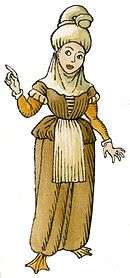Lamia (Basque mythology)

The lamia (plural: lamiak) is a siren- or nereid-like creature in Basque mythology.[1][2] Lamiak, laminak or amilamiak live in the river. They are very beautiful, and stay at the shore combing their long hair with a golden comb; they easily charm men. They have duck feet.
In coastal areas, some believed that there were itsaslamiak in the sea, who had fish tails—a kind of mermaid.
Beliefs
Lamiak help those who give them presents by providing them with help at work; if a farmer left them food at the river shore, they would eat it at night and in exchange would finish a field he had left unploughed. In some places, bridges were believed to have been built at night by lamiak: Ebrain (Bidarray, Lower Navarre), Azalain (Andoain, Gipuzkoa), Urkulu (Leintz-Gatzaga, Gipuzkoa), Liginaga-Astüe (Labourd).
In some places lamiak had to go away if the bridge they were building at night was left unfinished at cockcrow. People believed that lamiak had left a river if a stone of the bridge was missing. Most lamiak disappeared when men built small churches in the forest.
A lamia is at the other side of the rainbow combing her hair. When the sun lights her hair, the rainbow opens.
In some places male lamiak also exist; they are strong and have built dolmens at night. Sometimes they can enter a house when its inhabitants are sleeping. They are given different names: Maideak, Mairiak, Mairuak, Intxixuak (in Oiartzun, (Gipuzkoa), Saindi Maidi (in Lower Navarre).
Many toponyms are related to lamiak: Lamikiz (Markina), Laminaputzu (in Zeanuri), Lamitegi (in Bedaio), Lamirain (in Arano), Lamusin (in Sare), Lamiñosin (in Ataun).
See also
References
- ↑ "lamia". Orotariko Euskal Hiztegia. Euskaltzaindia (Academy of the Basque Language). Retrieved 12 July 2012.
- ↑ Williams, Elena Arana (1989). "Basque Legends in their Social Context". Essays In Basque Social Anthropology And History. Basque Studies Program. pp. 119–120. Retrieved July 12, 2012.